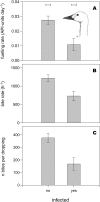Hampered foraging and migratory performance in swans infected with low-pathogenic avian influenza A virus
- PMID: 17264886
- PMCID: PMC1773019
- DOI: 10.1371/journal.pone.0000184
Hampered foraging and migratory performance in swans infected with low-pathogenic avian influenza A virus
Abstract
It is increasingly acknowledged that migratory birds, notably waterfowl, play a critical role in the maintenance and spread of influenza A viruses. In order to elucidate the epidemiology of influenza A viruses in their natural hosts, a better understanding of the pathological effects in these hosts is required. Here we report on the feeding and migratory performance of wild migratory Bewick's swans (Cygnus columbianus bewickii Yarrell) naturally infected with low-pathogenic avian influenza (LPAI) A viruses of subtypes H6N2 and H6N8. Using information on geolocation data collected from Global Positioning Systems fitted to neck-collars, we show that infected swans experienced delayed migration, leaving their wintering site more than a month after uninfected animals. This was correlated with infected birds travelling shorter distances and fuelling and feeding at reduced rates. The data suggest that LPAI virus infections in wild migratory birds may have higher clinical and ecological impacts than previously recognised.
Conflict of interest statement
Figures




Similar articles
-
Hampered performance of migratory swans: intra- and inter-seasonal effects of avian influenza virus.Integr Comp Biol. 2016 Aug;56(2):317-29. doi: 10.1093/icb/icw038. Epub 2016 Jun 1. Integr Comp Biol. 2016. PMID: 27252210 Free PMC article.
-
Effects of influenza A virus infection on migrating mallard ducks.Proc Biol Sci. 2009 Mar 22;276(1659):1029-36. doi: 10.1098/rspb.2008.1501. Proc Biol Sci. 2009. PMID: 19129127 Free PMC article.
-
Low Pathogenic Avian Influenza Viruses in Wild Migratory Waterfowl in a Region of High Poultry Production, Delmarva, Maryland.Avian Dis. 2017 Mar;61(1):128-134. doi: 10.1637/11476-072616-ResNote. Avian Dis. 2017. PMID: 28301229
-
Global patterns of influenza a virus in wild birds.Science. 2006 Apr 21;312(5772):384-8. doi: 10.1126/science.1122438. Science. 2006. PMID: 16627734 Review.
-
Impact of avian influenza on U.S. poultry trade relations-2002: H5 or H7 low pathogenic avian influenza.Ann N Y Acad Sci. 2004 Oct;1026:47-53. doi: 10.1196/annals.1307.006. Ann N Y Acad Sci. 2004. PMID: 15604469 Review.
Cited by
-
Demographic outcomes of diverse migration strategies assessed in a metapopulation of tundra swans.Mov Ecol. 2016 May 1;4:10. doi: 10.1186/s40462-016-0075-8. eCollection 2016. Mov Ecol. 2016. PMID: 27134751 Free PMC article.
-
Connecting the study of wild influenza with the potential for pandemic disease.Infect Genet Evol. 2013 Jul;17:162-87. doi: 10.1016/j.meegid.2013.02.020. Epub 2013 Mar 26. Infect Genet Evol. 2013. PMID: 23541413 Free PMC article. Review.
-
The Cloacal Microbiome of Five Wild Duck Species Varies by Species and Influenza A Virus Infection Status.mSphere. 2018 Oct 24;3(5):e00382-18. doi: 10.1128/mSphere.00382-18. mSphere. 2018. PMID: 30355662 Free PMC article.
-
Experimental challenge and pathology of highly pathogenic avian influenza virus H5N1 in dunlin (Calidris alpina), an intercontinental migrant shorebird species.Influenza Other Respir Viruses. 2011 Sep;5(5):365-72. doi: 10.1111/j.1750-2659.2011.00238.x. Epub 2011 Mar 15. Influenza Other Respir Viruses. 2011. PMID: 21668687 Free PMC article.
-
Bird Migration and Avian Influenza: A Comparison of Hydrogen Stable Isotopes and Satellite Tracking Methods.Ecol Indic. 2014 Oct 1;45:266-273. doi: 10.1016/j.ecolind.2014.04.027. Ecol Indic. 2014. PMID: 25045322 Free PMC article.
References
-
- Olsen B, Munster VJ, Wallensten A, Waldenström J, Osterhaus A, et al. Global patterns of influenza A virus in wild birds. Science. 2006;312:384–388. - PubMed
-
- Viney ME, Riley EM, Buchanan KL. Optimal immune responses: immunocompetence revisited. Trends Ecol Evol. 2005;20:665–669. - PubMed
-
- Hedenström A, Alerstam T. Optimal fuel loads in migratory birds: distinguishing between time and energy minimization. J Theor Biol. 1997;189:227–234. - PubMed
Publication types
MeSH terms
LinkOut - more resources
Full Text Sources
Medical

